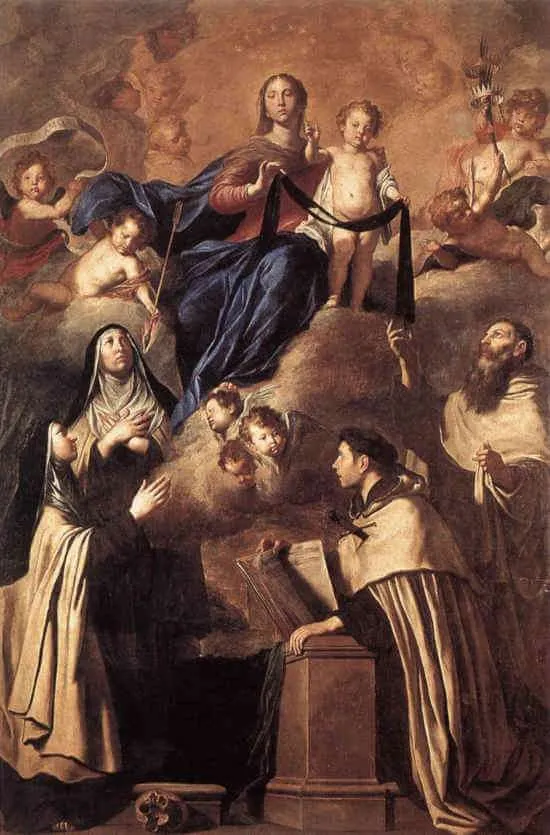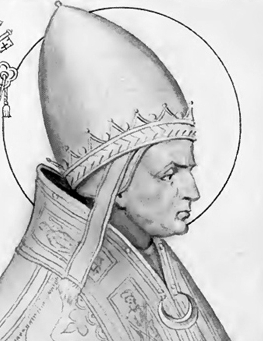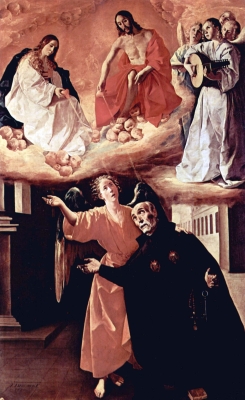c. 376–444; Patron Saint of Alexandria, Egypt; Invoked against Christological heresies; Pre-Congregation canonization; Declared a Doctor of the Church by Pope Leo XIII in 1883
After Jesus’ life, death, and resurrection, it is believed that Saint Mark, the Evangelist and Gospel writer, preached in Alexandria, Egypt, thus establishing the Christian faith in that city. Alexandria, founded in 331 BC by Alexander the Great, was situated on the northern edge of Africa, along the coast of the Mediterranean Sea. This strategic location rapidly turned it into an important trade center for Egypt, as well as a renowned hub for science, the arts, and learning. In 30 BC, Alexandria became a province of the Roman Empire, a status it would maintain for the next 700 years.
Christianity was legalized in the Roman Empire by Constantine the Great in 313. After that, major centers of Christian learning, such as Rome, Jerusalem, Antioch, Constantinople, and Alexandria became the stage for intense debates and developments in theology. Notably, these debates often revolved around Christ’s divine and human natures, His relationship with the Father and the Holy Spirit, and the appropriate title for the Blessed Virgin Mary. The outcomes of these debates provided the Church with a clear and foundational understanding of faith, which continues to deepen and evolve even today.
The fourth century saw the emergence of the Arian heresy, which taught that the Son was subordinate to the Father and not co-eternal. Saint Athanasius, then Bishop of Alexandria, tirelessly fought this heresy, enduring years of exile as a result. After the defeat of Arianism, other heresies surfaced. Fifty years after Athanasius’ death, Bishop Cyril of Alexandria would battle Nestorianism.
Cyril was born in the town of Theodosius, about eighty-five miles east of Alexandria. Given its proximity to Alexandria, Theodosius shared in the rich Greco-Roman culture and learning. Its close location to the Nile Delta also meant that farming and fishing were common activities. As a youth, Cyril’s uncle, Theophilus, the Patriarch of Alexandria, ensured that Cyril received an excellent education in theology, philosophy, rhetoric, and science. However, his uncle was a controversial figure in the Church. Less of an intellectual and more of a politician, Theophilus was power-hungry, harsh, often antagonizing Jews and pagans, and was known for stirring up controversy and violence. He was even responsible for deposing Saint John Chrysostom as Patriarch of Constantinople.
Around the year 412, Cyril succeeded his uncle as Patriarch, quickly discovering the challenge of following in his controversial footsteps. After a group of violent monks murdered a prominent pagan philosopher, astronomer, and mathematician, Cyril was blamed, despite his lack of involvement. Being the nephew of Patriarch Theophilus had its drawbacks, and Cyril proceeded in his ministry with caution. He eventually moved out of the shadow of his uncle, establishing himself to be an intelligent and faithful servant of God and His Church. He began to write Scripture commentaries with theological precision, especially when it came to the nature of Christ, addressing the various heresies of the time. Within a decade of being a bishop, Cyril had established the reputation of being a trustworthy and articulate teacher of the faith.
In 428, the emperor appointed Nestorius as Patriarch of Constantinople. Shortly afterward, Patriarch Nestorius assigned a priest from Antioch to preach throughout Constantinople. The priest began challenging the widely accepted notion that Mary was rightly called the Mother of God (Theotokos), suggesting instead she should only be referred to as the Mother of Christ (Christotokos). This proclamation stirred controversy among the faithful in Constantinople, and news quickly spread across the empire, eventually reaching Patriarch Cyril, over 1,000 miles away in Alexandria.
Cyril vehemently disagreed with this new heresy, which later became known as Nestorianism. He began to preach and teach against it among his own people, clarifying that Mary was rightfully termed the Mother of God. He explained that this title was not solely about the Blessed Mother, but also about the essence of Christ. If Mary wasn’t the Mother of God, then Christ’s essence was divided. Nestorianism proposed that Jesus was a divine person somehow united with a distinct human person, and Mary was only the mother of His humanity. Cyril corrected this misinterpretation, emphasizing that there was only one Person in Christ, both human and divine. This made Mary not only the mother of her human Son but also the mother of His personhood, thereby justifying her title as the Mother of God. After teaching his people, Cyril wrote private letters to Nestorius to correct him. Nestorius rejected the correction. Consequently, Cyril broadened his correspondence, involving other bishops, members of the emperor’s court, and the pope in Rome. This pleased the faithful in Constantinople but enraged Nestorius. The pope investigated and authorized Cyril to deal with Nestorius with the pope’s authority.
In 431, the Roman emperor felt the need to intervene and called a Church Council in Ephesus to settle the dispute. Ephesian Christians were known for their devotion to the Mother of God, partly due to the deeply held tradition that Mary had settled in Ephesus later in life with Saint John. Thus, the council’s location signaled the emperor’s opposition to Nestorius. Once many of the bishops from across the empire had gathered, but before Nestorius and his supporters arrived, Cyril opened the council. He took the lead and eloquently articulated his position, which was consistent with the teachings of earlier Church Fathers. The bishops present at the council accepted his explanation and voted to condemn Nestorius. On arrival, Nestorius and his supporters were outraged that the council had proceeded without them. In retaliation, they held their own meeting, voted in opposition, and attempted to depose Cyril. When the emperor heard of this, his representative attempted to resolve the dispute by jailing both Nestorius and Cyril to force an agreement. Eventually, however, the emperor sided with Cyril, due to his popular support among the people. When Nestorius refused to accept this position, he was exiled to the Egyptian desert.
Upon returning to Alexandria, Cyril continued to write and teach. Later generations conferred upon him the titles “Guardian of Exactitude” and “Seal of the Fathers,” for he successfully synthesized the teachings of the Church Fathers who preceded him, applying those teachings to the present disputes. As we honor him today, ponder the significance of precision in your faith. Without precision that is consistent with all that has been taught before us, we risk failing to fully understand Christ. Reflect on your commitment to a deep and clear understanding of God and our faith, and reaffirm your fidelity to the truth.
Source: https://mycatholic.life/saints/saints-of-the-liturgical-year/june-27—saint-cyril-of-alexandria-bishop-and-doctor/







